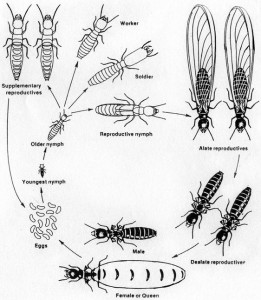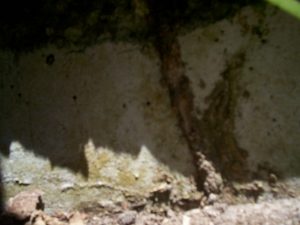Such a destructive force of nature, so small and so misunderstood. Did you know termites out weigh humans on earth? Or that they were the number one destroyer of paper money? I’ll bet you had no idea that they produce more methane/C02 gas than any other organism. Al Gore should be an advocate of pest control companies. (my guess is that he no idea)
Able to fit through tiny cracks less than 1/64 of an inch, silent and totally blind termites do more damage to homes than storms and fires combined. Most home owners have no idea that their home has been invaded until significant damage has been done. The average size ‘mature’ colony is at least 60,000 strong and that is only a 2 to 3 year process. Many colonies exceed into the millions in short order once established. These ‘mature’ colonies produce swarmer termites that can come out of a pin hole in your wall by the tens of thousands only to disappear back into the dark abyss leaving the only clue a homeowner sees as they come home from work–.thousands of tiny wings on the floor and window sill in a room of their home. A curious look and a quick vacuum and all is forgotten. Perhaps later that year or some year after the window sill begins to sag and ‘mud’ seems to be growing out of the drywall. A call to a local pest company and complete shock ensues. TERMITES!, how can this happen? How long have they been there? How did they get in? How MUCH did you say to treat for them?$$$$$$$$$$$
Lets start from the beginning
 home in this stage but are simply used to create new colonies and keep the species going. Usually on a spring morning before noon and a day after a nice spring rain they will be ‘herded’ out of the ground or wall cavity to take flight. This only lasts a short time and being poor fliers with no defenses, they are at the mercy of the wind or end up as easy pickens for birds, spiders and other predatory critters.( not to mention the home owner armed with a can of Raid should they be at home during the exodus) Although tens of thousands may swarm usually less than 10 pairs will be successful enough to evade all the initial dangers and have a chance of establishing a new colony.
home in this stage but are simply used to create new colonies and keep the species going. Usually on a spring morning before noon and a day after a nice spring rain they will be ‘herded’ out of the ground or wall cavity to take flight. This only lasts a short time and being poor fliers with no defenses, they are at the mercy of the wind or end up as easy pickens for birds, spiders and other predatory critters.( not to mention the home owner armed with a can of Raid should they be at home during the exodus) Although tens of thousands may swarm usually less than 10 pairs will be successful enough to evade all the initial dangers and have a chance of establishing a new colony.
Once back on the ground the swarmer termites shed their fragile wings by arching their backs until the wings snap off. From there the female lets out a sex pheromone to attract a mate. The males scurry about looking for mates lured by the scent. When the two are united the male follows the female like tail gator in a hurry. Quickly they must find shelter whether it’s under a rock or leaves, anything to provide some protection from the gathering predators. At this time they may mate and begin to construct a one cell cavity they’ll call home. Only a few eggs will be laid shortly after this and the newly wed king and queen are in charge of gathering food, tending the nest and protecting the eggs.
 Termites have a gradual metamorphosis so when the eggs hatch the newborns resemble the adults and after a short time are busy at work taking some of the responsibilities from the king and queen. More eggs are laid and more termites are produced. A unique aspect of termites is the caste system. All termites are born as workers and these worker termites are responsible for all the food (thus the damage to your homes) and construction of tunnels, tending to the young and any other menial task that needs doing. As they grow they shed their skin as they get bigger till full grown. At certain points however the worker termite can change into another ‘caste’ according to the colonies needs. Say a recent invasion of ants has killed many of the soldier caste as well as many workers. The need for colony protection is paramount and workers at this time of change will begin to form into soldiers. When the number of soldiers is sufficient it stops or resumes to normal. Similarly should swarmer’s or supplementary reproductives be needed, workers will begin the same process and form into these castes.
Termites have a gradual metamorphosis so when the eggs hatch the newborns resemble the adults and after a short time are busy at work taking some of the responsibilities from the king and queen. More eggs are laid and more termites are produced. A unique aspect of termites is the caste system. All termites are born as workers and these worker termites are responsible for all the food (thus the damage to your homes) and construction of tunnels, tending to the young and any other menial task that needs doing. As they grow they shed their skin as they get bigger till full grown. At certain points however the worker termite can change into another ‘caste’ according to the colonies needs. Say a recent invasion of ants has killed many of the soldier caste as well as many workers. The need for colony protection is paramount and workers at this time of change will begin to form into soldiers. When the number of soldiers is sufficient it stops or resumes to normal. Similarly should swarmer’s or supplementary reproductives be needed, workers will begin the same process and form into these castes.
As the colony grows in numbers, the royal parents do less and less. The need to expand the nest and get the queen deeper into the ground for protection is vital. As the queen grows into a HUGE egg laying machine she’ll soon be unable to move on her own and shes doomed to spend the rest of her life (up 30 years if all goes well) in her royal chamber being groomed, fed and tended to round the clock. The nest is a well organized community really. The eggs are carried to a chamber area of their own, the very young are confined to the immediate nest area and do only minimal tasks. When the colony is going strong it even comes complete with a ‘mushroom farm’ which termites use to supplement their diet.
From the nest subterranean tunnels take off in almost every direction. Only the workers and the soldiers leave the nest through these tunnels for now. For years it was believed that termites found food by total random foraging. The tunnels had no rhyme or reason. Since termites are blind and shun light this seemed logical. Recent studies have however de-bunked some of this thinking by showing termites were able to zero in on possible feeding sites by following root systems of trees or slab surfaces until they’ve found a crack that allows them entry into a structure. Also termites require constant moisture and will seek out wetter areas and explore them exhaustively in search of food. Areas such as your a/c drip line or gutter downspout or the shrubbery area around your home that is regularly watered with the sprinkler system. 24 hours per day 365 days per year termites are constantly foraging and feeding as the colony is also constantly growing each and everyday.
Once termites have found your home the workers establish several ‘traffic’ tunnels and exude a pheromone trail other workers can follow to this new site. Soldiers also roam the tunnel system ready to snap and pinch any intruder should the tunnels be broken open. Interestingly soldiers will bang their heads on the sides of the tunnels or infested wood when danger is present. This sounds an alarm and the workers rush to cover and soldiers hurry to the security breach. If the ant or intruder tries to enter the exposed tunnel the soldiers will snap their powerful mandibles literally cutting the enemy in half. The workers frantically try to rebuild the broken tube over the backs of the soldiers and seal the assassins out.
to this new site. Soldiers also roam the tunnel system ready to snap and pinch any intruder should the tunnels be broken open. Interestingly soldiers will bang their heads on the sides of the tunnels or infested wood when danger is present. This sounds an alarm and the workers rush to cover and soldiers hurry to the security breach. If the ant or intruder tries to enter the exposed tunnel the soldiers will snap their powerful mandibles literally cutting the enemy in half. The workers frantically try to rebuild the broken tube over the backs of the soldiers and seal the assassins out.
Tunnels are made up of soil, termite saliva and fecal matter and since they are vulnerable with breaks or during construction work is done quickly. Once danger is past termites resume what they do best….eating wood. Subterranean termites only eat the soft wood in a structure leaving the hardwood rings in tact for the most part. Workers rip the cellulose (wood) apart fiber by fiber. If you could hear the termites eating it would sound similar to popcorn popping. When the belly of a worker is full it heads back to the nest for another important duty.
Feeding the termites back at the nest
Termites can’t digest wood by themselves. They have a ‘protozoa’ in their gut that helps turn the cellulose into sugar, which is something they can digest. This little helper is so important to the survival of a termite. Without it the entire colony would die with their bellies full. Termites communicate via ‘trophylaxis’ that is they exchange liquids mouth to mouth and sometimes protozoa are exchanged this way as well. If a worker is left without his protozoa you can bet he’ll be chatting up with all his buddies till he has one given to him. The members in the colony that never leave the nest also need to eat but don’t get the chance to taste your window sill. They wait for returning workers who will share their food in liquid form via trophylaxis. The queen eventually will eat this way as well but only after shes sure the food is safe. If workers and others are dying or getting ill she won’t eat anything until the problem is solved and the coast is clear. The queen isn’t fed until ‘tasters’ have eaten and the food hasn’t made any of them sick. This is a security measure to keep the queen safe that ants are known to do as well.
Nature at its finest.





